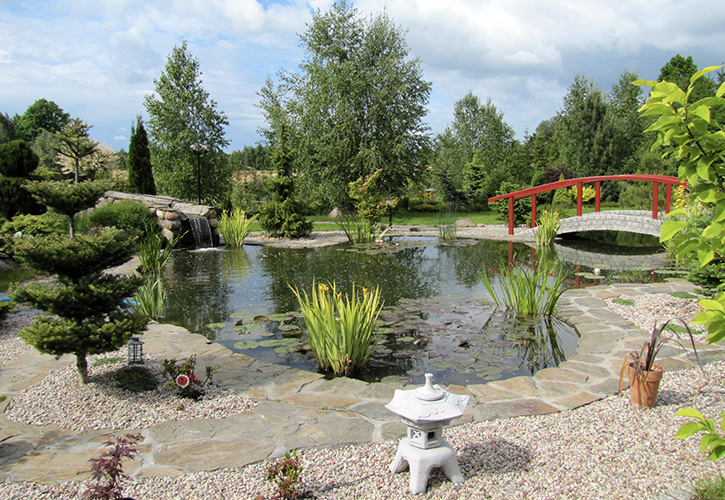Have you ever dreamed of a relaxing and harmonious landscaping ? Have you considered a Zen garden? Also known as the Japanese garden, this landscaping is perfect when it comes to creating a balanced sensation between the different natural elements that make it up.
For a quick overview, here are 4 elements to integrate into your yard to recreate the sober and symbolic atmosphere that characterizes the perfect Zen garden.
1.Water
Water is a natural element that symbolizes both fluidity and purity. This natural element is omnipresent in most types of Japanese gardens. You can choose from a wide range of options to enhance its place in your garden!
Here are few inspiring suggestions, depending on your preferences and the space available in your garden.
Waterfalls and pools
Waterfalls that run into pools are natural and soothing, and are pleasant to watch and listen to.
Source : Pinterest
Falls
No matter how small, falls usually create a beautiful effect, as well as a steady, comforting sound.
Source : Pinterest
Fountains
Fountains have recently been introduced to contemporary Japanese decor, making it easy to add an aquatic element to your garden.
Source : Pinterest
Source : Pinterest
2. Japanese Steps
Japanese footsteps are simply natural stone slabs laid out to form a path through lawn, earth or water. A Zen garden without this unique touch would definitely not be one! Here are a few inspiring illustrations.
Source : Pinterest
Source : Pinterest
Source : Pinterest
3. Plants for a Zen garden
Here are some plants that will give your garden that special Japanese look.
Saskatoon
Saskatoons are a good sized shrub, and their multiple features combine to make them a radiant plant all year round! Its beautiful white flowers bloom in spring and produce small bluish fruits in early summer. It adorns with blazing colors in the fall, and maintains its elegant silvery bark even in winter. In Japan, it is mainly used as an ornamental tree in parks and gardens.
Peonies
Peonies are huge fragrant flowers that often find their place in our flower beds. They are available in many varieties, colors and shapes. Every year, they fade during winter and bloom again between spring and summer. Back then in Japan, only the wealthiest people could grow peonies, which symbolized prosperity.
Irises
Irises are delicate and graceful, with beautiful sized flowers in shades of blue, pink or white that catches the eye. The elegance of these flowers conveys with simplicity the quest for beauty that emanates from Zen gardens and ancestral Japanese art.
Rhododendrons
Rhododendrons are very colorful plants and easy to maintain, but they require rich and airy soil conditions to grow undisturbed. Their abundant flowers, with delicate petals, come in shades ranging from red to pink, through white and purple.
Crabapple trees
Who is not familiar with Japanese springtime images of blossoming cherry trees ? Quebec’s climate is unfortunately not conducive to this type of tree surviving our extreme temperature gaps ! As an alternative, crabapple trees can play an equally enchanting role. With their multiple pink and white flowers, they easily symbolize renewal and beautify within your backyard.
4. Stone, sand and gravel
Stone, sand and gravel symbolize earth, durability and the constant presence of natural forces in our environment. These elements give the Japanese garden that extra touch of personality. This is why these relief elements should be integrated into your design.
Source : Pinterest
Source : Pinterest
Source : Pinterest
Having a Zen garden at home transforms your landscaping and offers you a small serene oasis. Would you like to realize this kind of garden? Download our ultimate guide of the 7 must-do steps to achieve your project!


















